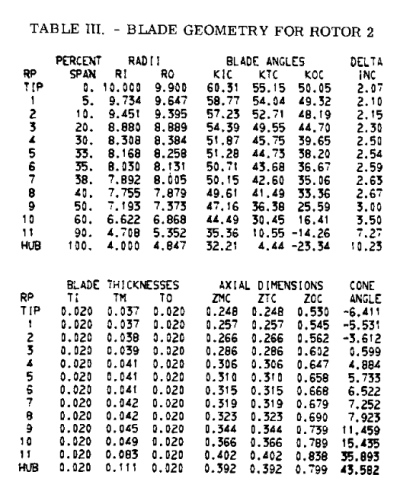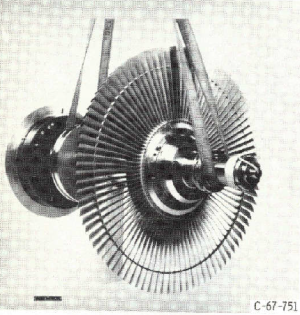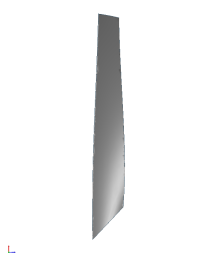Table des matières
Rotor 2
About
Rotor 2 is part of a research program to study aspect ratio because the use of high aspect ratio blading can lead to a decrease in the axial length of compressors and therefore a reduction of their size and weight. To investigate the effects of aspect ratio on compressor range and efficiency, two transonic rotors (rotor 1 and 2) were designed and tested. The variation in aspect ratio was based on a change in aerodynamic chord, and the solidity was kept the same by varying the number of blades.
- Original technical report [1]:
@TechReport{reid1974design, author = {Reid, L. and Tysl, Edward R.}, date = {1974}, institution = {NASA Lewis Research Center Cleveland, OH, United States}, title = {Performance of a transonic compressor rotor with an aspect ratio of 6.5}, number = {NASA-TN D-7662}, url = {https://ntrs.nasa.gov/citations/19740018136}, } - Picture :
Useful documents
- NASA technical report (.pdf)
- geometrical parameters file (.csv), usable as input of OpenMCAD[2] to generate reference blade models.
Reference blade
The reference blade is defined with multiple-circular arc profiles[3] given in the original NASA report[4]. Corresponding models are computed with the open-source code OpenMCAD[2].
Geometry
The geometry of rotor 2 is described in the original NASA report by the following tables. The length are in inches and the angles in degrees.

Aerodynamic design
| unit | value | |
|---|---|---|
| pressure ratio | [-] | 1.53 |
| mass flow | [kg/s] | 30.7 |
| tip speed | [m/s] | 350.8 |
| tip solidity | [-] | 1.3 |
| aspect ratio | [-] | 6.5 |
| rotative speed | [rad/s] | 1381.25 |
Material properties
The material of rotor 2 is not defined in the original NASA report. A 200-grade maraging steel is considered:
| unit | value | |
|---|---|---|
| alloy | [-] | 18-Ni-200-maraging |
| Young's modulus | [GPa] | 180 |
| density | [kg/m3] | 8000 |
| Poisson's ratio | [-] | 0.3 |
| yield stress | [GPa] | 1.38 |
CAD model
The CAD model is computed with the open source code OpenMCAD[2].
Natural frequencies
First three natural frequencies (with clamped root) for the mesh computed with OpenMCAD[2]:
À propos
Le rotor 2 fait partie d'un programme de recherche visant à étudier l’allongement des aubes, car l'utilisation d’un fort allongement peut conduire à une diminution de la longueur axiale des compresseurs et donc à une réduction de leur taille et poids. Pour étudier les effets de cet allongement sur les rendements des compresseurs, deux rotors transsoniques (rotor 1 et 2) ont été conçus et testés. La variation d’allongement entre ces deux rotors a été effectuée grâce à une modification de la corde aérodynamique et la solidité a été maintenue identique en faisant varier le nombre d'aubes.
- Rapport technique original [1]:
@TechReport{reid1974design, author = {Reid, L. and Tysl, Edward R.}, date = {1974}, institution = {NASA Lewis Research Center Cleveland, OH, United States}, title = {Performance of a transonic compressor rotor with an aspect ratio of 6.5}, number = {NASA-TN D-7662}, url = {https://ntrs.nasa.gov/citations/19740018136}, } - Photographie :
Documents utiles
- rapport technique original de la NASA (.pdf)
- fichier de paramètres géométriques (.csv), utilisable en entrée de OpenMCAD[2] pour générer l'aube de référence
Aube de référence
L'aube de référence est définie par des profils de type arcs circulaires multiples[3], donnés dans le rapport technique original de la NASA[4]. Les modèles associés sont obtenus avec le code en libre accès OpenMCAD[2].
Géométrie
La géométrie du rotor 2 est décrite dans le rapport d'origine de la NASA par les tableaux suivants. Les grandeurs sont en pouces et en degrés.
Caractéristiques aérodynamiques
| unités | valeurs | |
|---|---|---|
| taux de compression | [-] | 1,53 |
| débit massique | [kg/s] | 30,7 |
| vitesse en tête | [m/s] | 350,8 |
| solidité en tête | [-] | 1,3 |
| allongement | [-] | 6.5 |
| vitesse de rotation | [rad/s] | 1381,25 |
Propriétés matériau
Le matériau original du rotor 2 n'est pas défini dans le rapport de la NASA. Un acier maraging de grade 200 est considéré:
| unité | valeurs | |
|---|---|---|
| alliage | [-] | 18-Ni-200-maraging |
| module d'Young | [GPa] | 180 |
| masse volumique | [kg/m3] | 8000 |
| coefficient de Poisson | [-] | 0,3 |
| limite élastique | [GPa] | 1,38 |
Modèle CAO
Fréquences propres
Fréquences des trois premiers modes (noeuds du pied d'aube encastrés) pour le maillage obtenu avec OpenMCAD[2] :
</tabs>


